Last Saturday, James’ analysis explained how Manchester City won at a 5-3 thriller at the Etihad Stadium. However, we all knew that Pep Guardiola’s Manchester City gave away the two-goal margin in the second leg as Leonardo Jardim’s Monaco were able to come back with a 6-6 aggregate at the Stade-Louis II, and so progressed in the UEFA Champions League.
In this tactical analysis, we will show you the details of this game by looking at the tactics of both Guardiola and Jardim.
Lineups and overview
Monaco played in a 4-4-2 formation and their lineup was very similar to the first leg. However, their key striker of that season, Radamel Falcao, missed the game because of a fitness issue. Kylian Mbappé and Valère Germain were paired as the forwards.
City’s setup was quite different from the last game and there were especially some huge changes at the defence. Fernandinho returned to the midfield, with Gaël Clichy playing as the left-back. The partner of John Stones was Aleksandar Kolarov instead of Nicolás Otamendi. Willy Caballero continued to start in goal over Claudio Bravo.
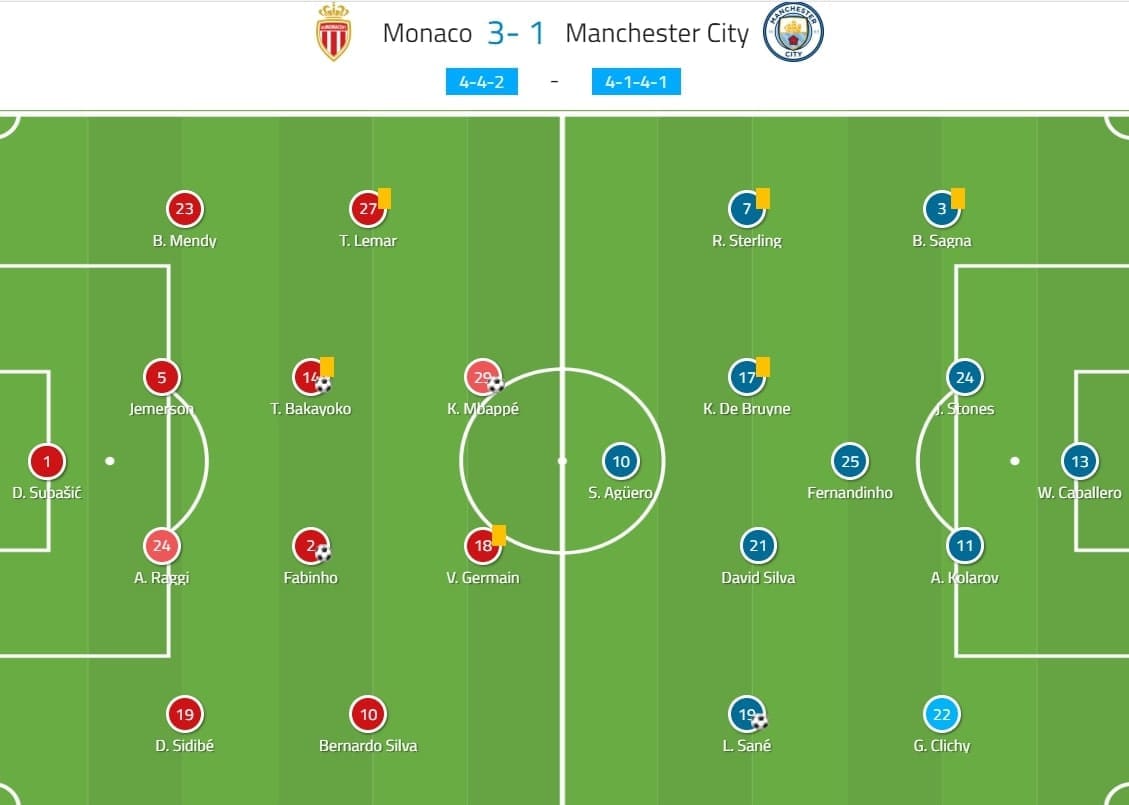
The below graph illustrates the xG dynamics of the game. Since City failed to register a shot in the first half, their xG was 0.00. After the break, City were trying everything to get a goal, and at the time Leroy Sané scored the goal, the xG nearly equalised.
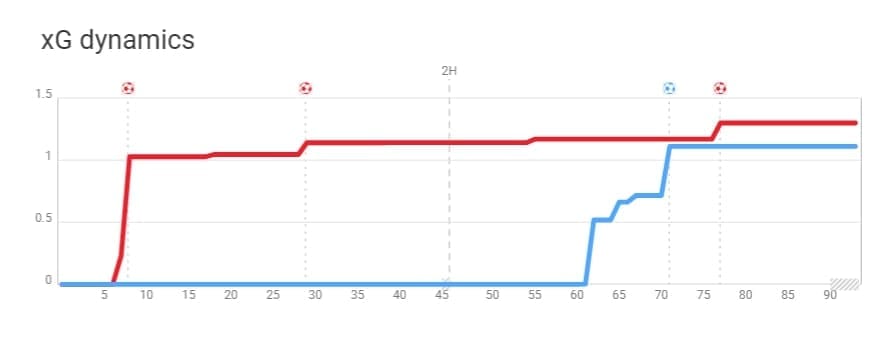
Monaco’s style of play
Monaco successfully defended against City by bringing an intense game. Defensively, their shape varied from situations. The first one was a 4-2-2-2 shape as we outlined below. The two wingers were tasked to stay slightly higher at the half-spaces as they had to stay close with the full-backs. The central midfielders stayed deep, marking the advanced midfielders of City tightly. None of them were tasked to man-mark Fernandinho, hence why they left a gap between lines.
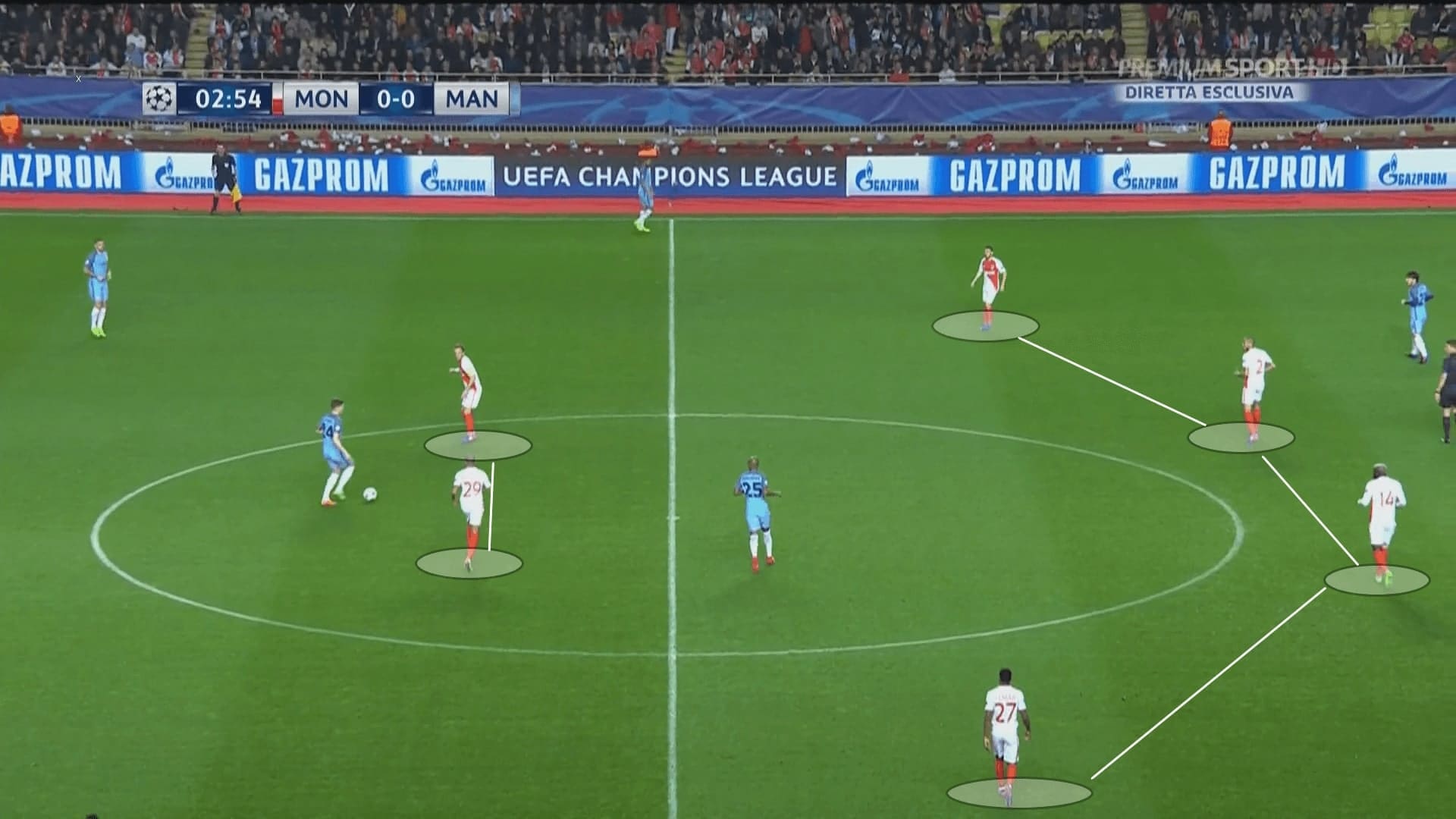
The compactness of the defence is a relative concept, as it depends on the players. For example, we could see Monaco defending in a 4-4-2 shape as illustrated in the below image. City inverted their full-backs to create a passing triangle and overload the Monaco strikers. The vertical compactness of the team seemed inadequate, but the physical qualities of players proved this was good enough to pressure the opponents. Jardim’s men were sharp, quick, and hungry to challenge City players.
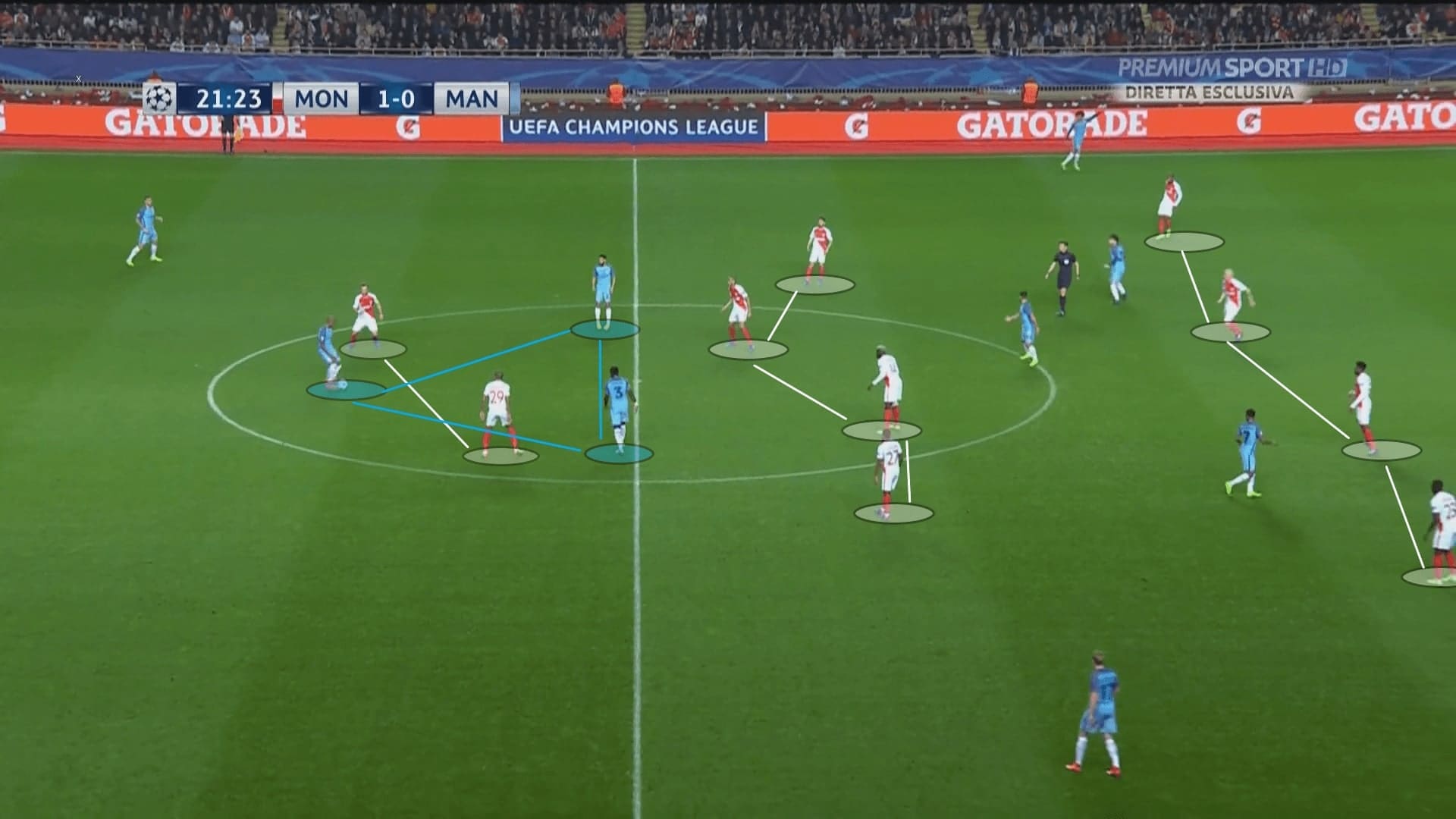
However, the defensive shape could become a 4-3-3 when one of the wingers stepped out and joined the frontline. Merely relying on the strikers was not enough to cover the pitch horizontally, so adding a winger evened things up. However, the focus of the wingers remained the same – controlling the full-backs. The defensive actions included shutting a wide passing lane to the full-back, such as the instance as we indicated below where Bernardo Silva shut the pass to Clichy.
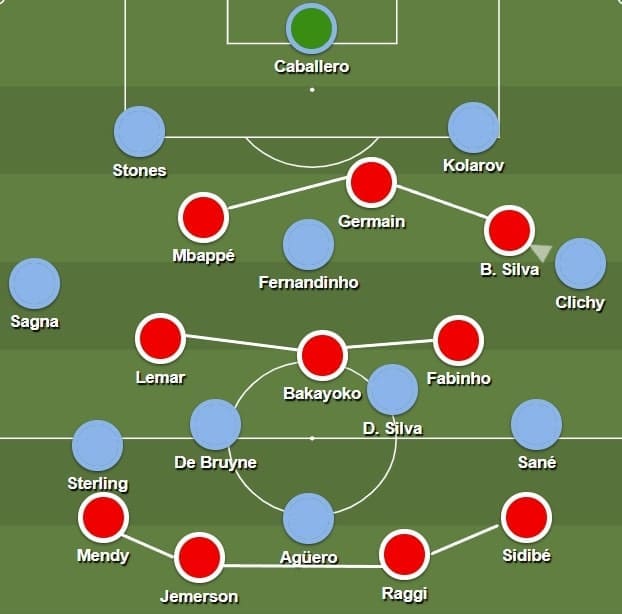
Apart from the very regular offensive support from the left-back, Benjamin Mendy, Jardim’s team relied on quick transitions to create their chances, and one of them created Mbappé’s opener. As Guardiola said, in the first half Monaco won a lot of second balls. This was one of the reasons that they had the opportunities in the first half.
Why did Monaco win a higher proportion of second balls in the first half? One of the reasons was the defensive setup of City. The sole pivot of the Citizens, Fernandinho, stayed very deep to get involved in the aerial duels. Therefore, the Brazilian was merely in front of his defenders, but another two midfielders did not retreat on time. The gap at the midfield was enormous, and as Clichy’s and Bacary Sagna’s role as the inverted full-backs were not fixed, they lacked the mobility to arrive in the right area for the second balls.
As you can see in the below image, Fernandinho initially headed the first ball. Meanwhile, his distance between himself and David Silva was huge, while Kevin De Bruyne was unseen in this image. Sagna and Clichy were far from the dropping ball. However, it was not Mbappé who was there to pick the second ball, instead, it was the accelerating Thomas Lemar ready to carry the ball into the final third. In cases like this, City could do nothing to stop the ball carrier to progress.
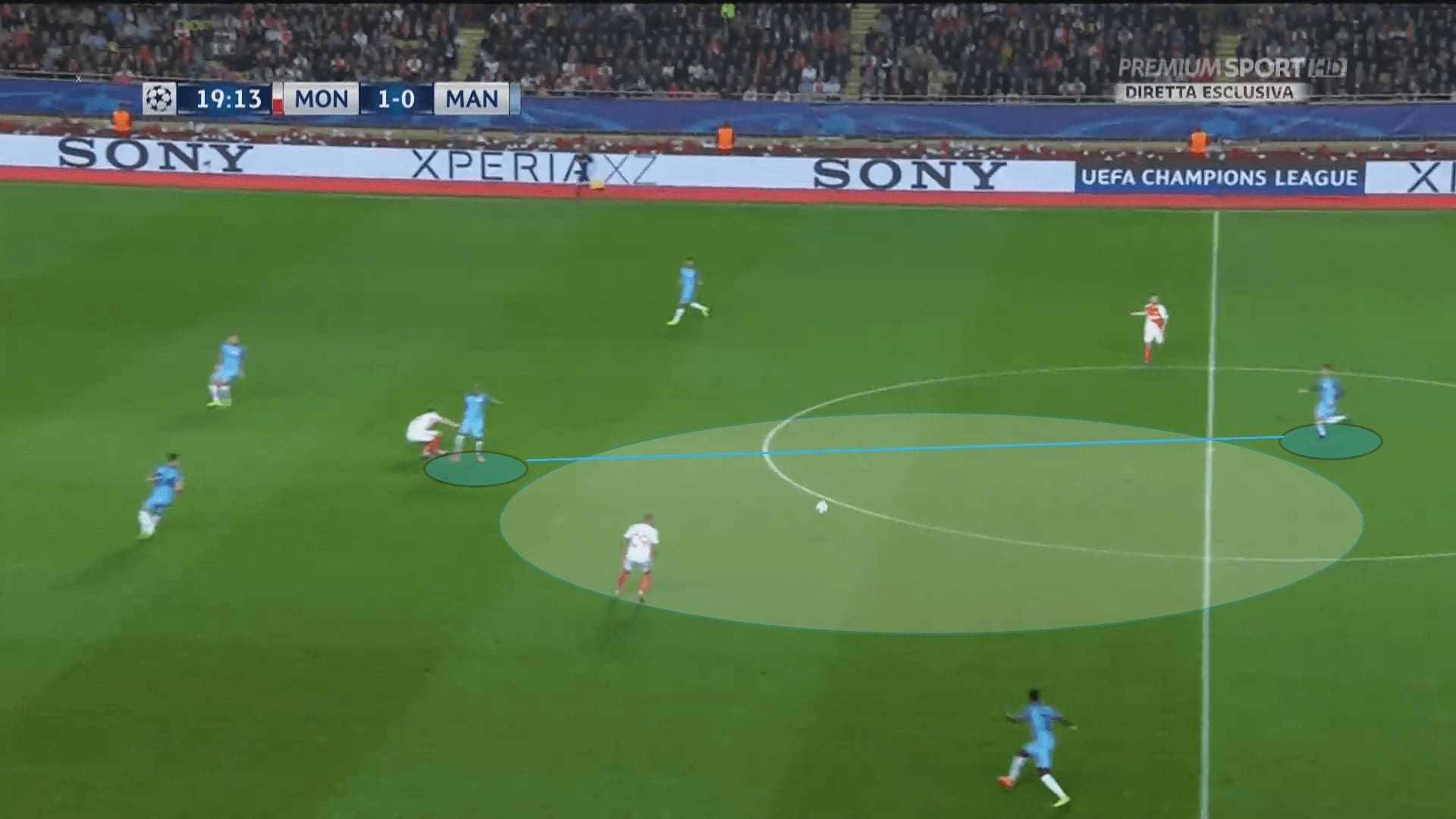
The battle at the half-spaces was intense in the first half. Thanks to the inverted positionings of the wingers, Monaco had two energetic players to compress spaces. Also, both Fabinho and Tiémoué Bakayoko pressed the dropping players of City tightly, which additionally helped Monaco recover the ball high, and furthermore turned them to opportunities.
The following image is the recoveries of Monaco in the first half. At both half-spaces, Jardim’s men recovered the ball 13 times, and one of them led to Mbappé’s goal. They were solid in the duels, as they recovered the ball 26 times in the whole game.
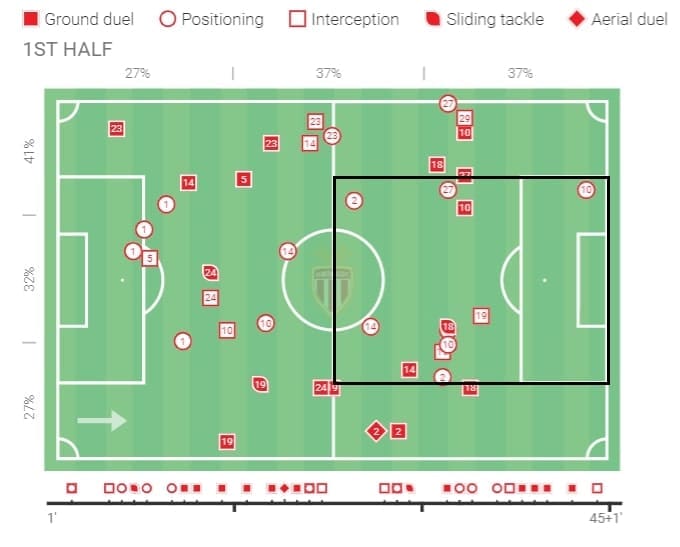
In the second half, Monaco’s defence was pushed deep because of City’s attacks. When defending in a low block, Monaco stuck to their 4-4-2 formation, with the midfielder pressing early to keep the pressure. Furthermore, City attacked the half-spaces of Monaco and gave Jardim’s team a hard time, as we will explain their tactics in the coming sections.
In the final stages of the game, João Moutinho came on for Mbappé, the team formation switched to a 4-4-1-1. This change was more than changing the formation – Jardim’s team tried to maintain the level and cover the half-spaces better. In the 4-4-2 formation, the strikers defended less in their own half, so either Bakayoko or Fabinho had to step out to press, leaving spaces behind them. More importantly, the markings on D. Silva was loose.
Playing Moutinho behind the striker not only maintained the level of pressure, but they also allowed Bakayoko to defend in front of the box, covering the half-spaces, marking D. Silva. As you can see in the following image, D. Silva could not pass to Raheem Sterling as the passing lane was shut. This kept Monaco in the game to progress.
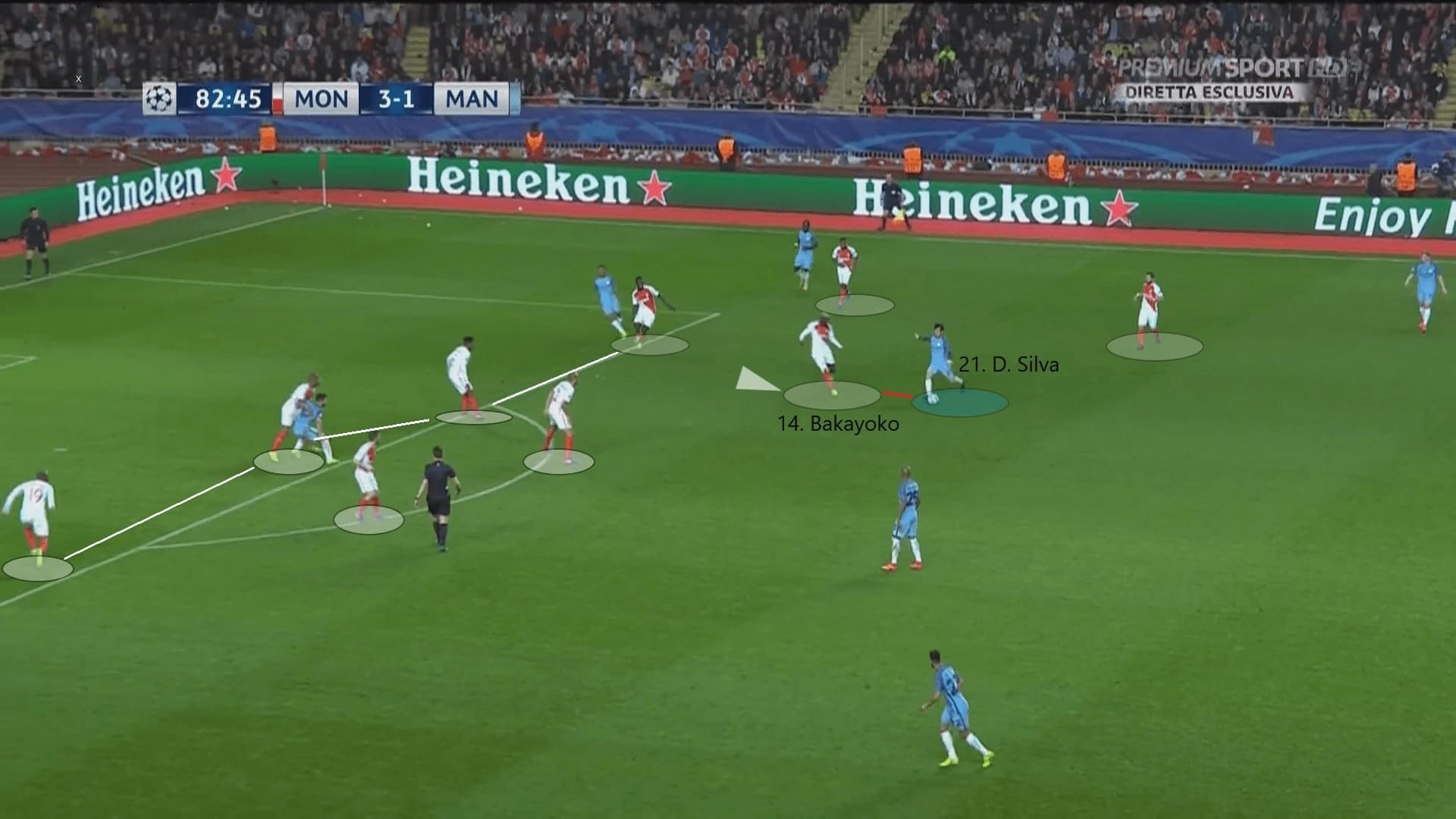
City’s poor first half
Of course, City tried to play out from the back as they did in almost every game. In the first phase of the attack, it was well-planned. With Stones and Kolarov spreading wide, including Caballero and Fernandinho, they had a 4 v 2 numerical advantage to nullify the first line of Monaco press.
Hypothetically, if the two pressing players marked the centre-backs in the half-spaces, the vertical passing lane from Caballero to Fernandinho was opened. If one of Monaco strikers marked Fernandinho, then there must be at least one free centre-back. Monaco kept Fabinho and Bakayoko deeper to control D. Silva and De Bruyne. In this case, spaces between the lines were generated as highlighted below. The front players of City were free to drop into the highlighted area for ball progression, pulling defenders out of positions.
For the full-backs, they were flexible to invert or stay wide, depending on the situations. Usually, Sagna stayed at the half-spaces when Fernandinho dropped deep – this ensured numbers at the centre in case of quick transitions. If not, they stayed wide to stretch the defence. However, as explained, the ball progressions via the full-backs were weak as the coverage of Lemar and B. Silva were too good.
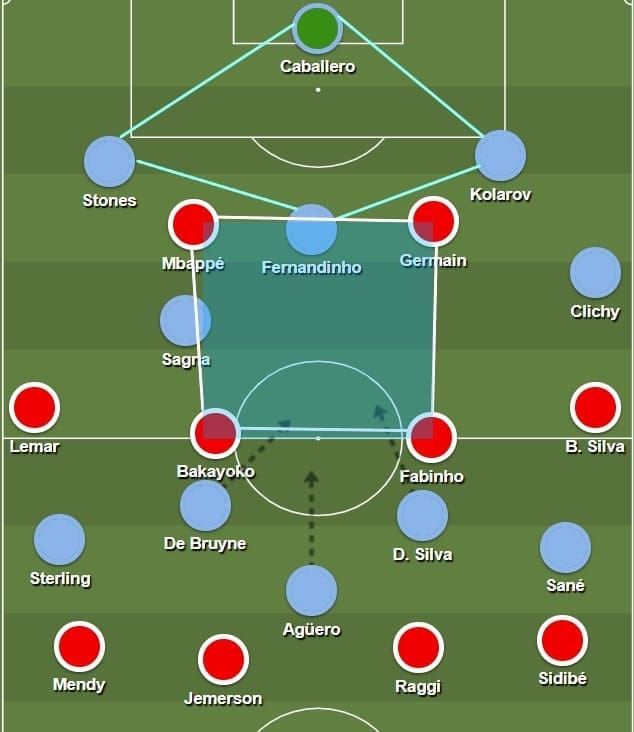
The below case was an example. Given spaces at the centre, Fernandinho had the ball and tried to break the first line of Monaco by carrying the ball forward. However, both Monaco strikers tracked the Brazilian tightly and Germain’s challenge eventually led to a possession turnover. Monaco recovered the ball high and had a quick transition.
As demonstrated by the image, the shape of City was beautiful. They had the full-backs to stay wide and provide the width, and they had six players at the centre to create an overload against Monaco players. The problem was the execution, as Monaco brought this game to an intense one, and exposed the issue of the lack of physicality of the City players.
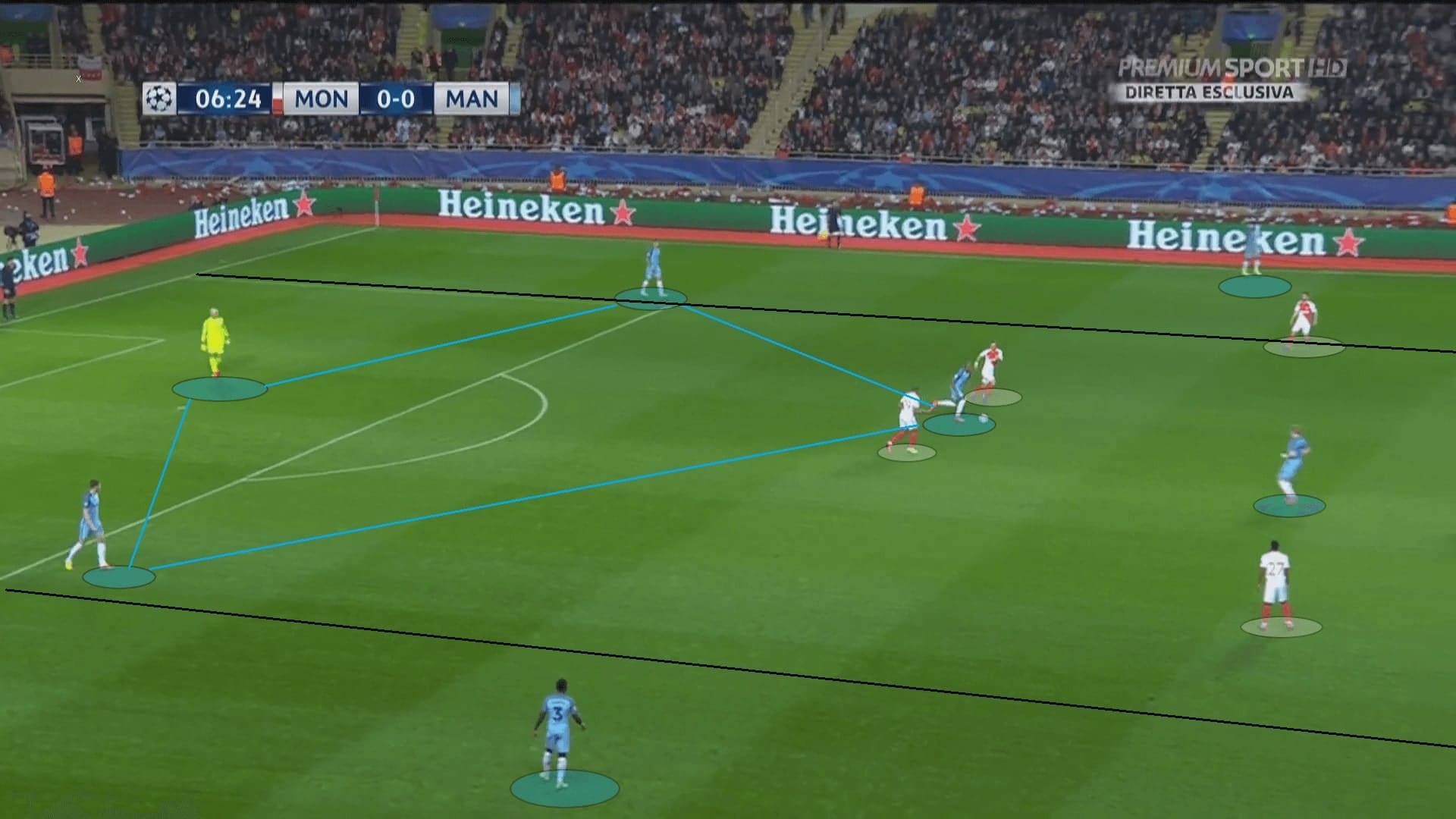
When City tried to play the out ball to a dropping front player, they faced huge difficulties because of the tight markings of the Monaco centre-backs or midfielders. If it was D. Silva or De Bruyne to drop, Fabinho and Bakayoko stayed tight at their back to prevent the receiver from turning. If it was Sergio Agüero, he had either Andrea Raggi or Jemerson at his back.
Under pressure, City players were uncomfortable, and the executions of their next moves were adversely affected. For example, in the following image, Agüero’s first touch made the ball bounce because of the pressure from Raggi and therefore he had to take extra time to control it.
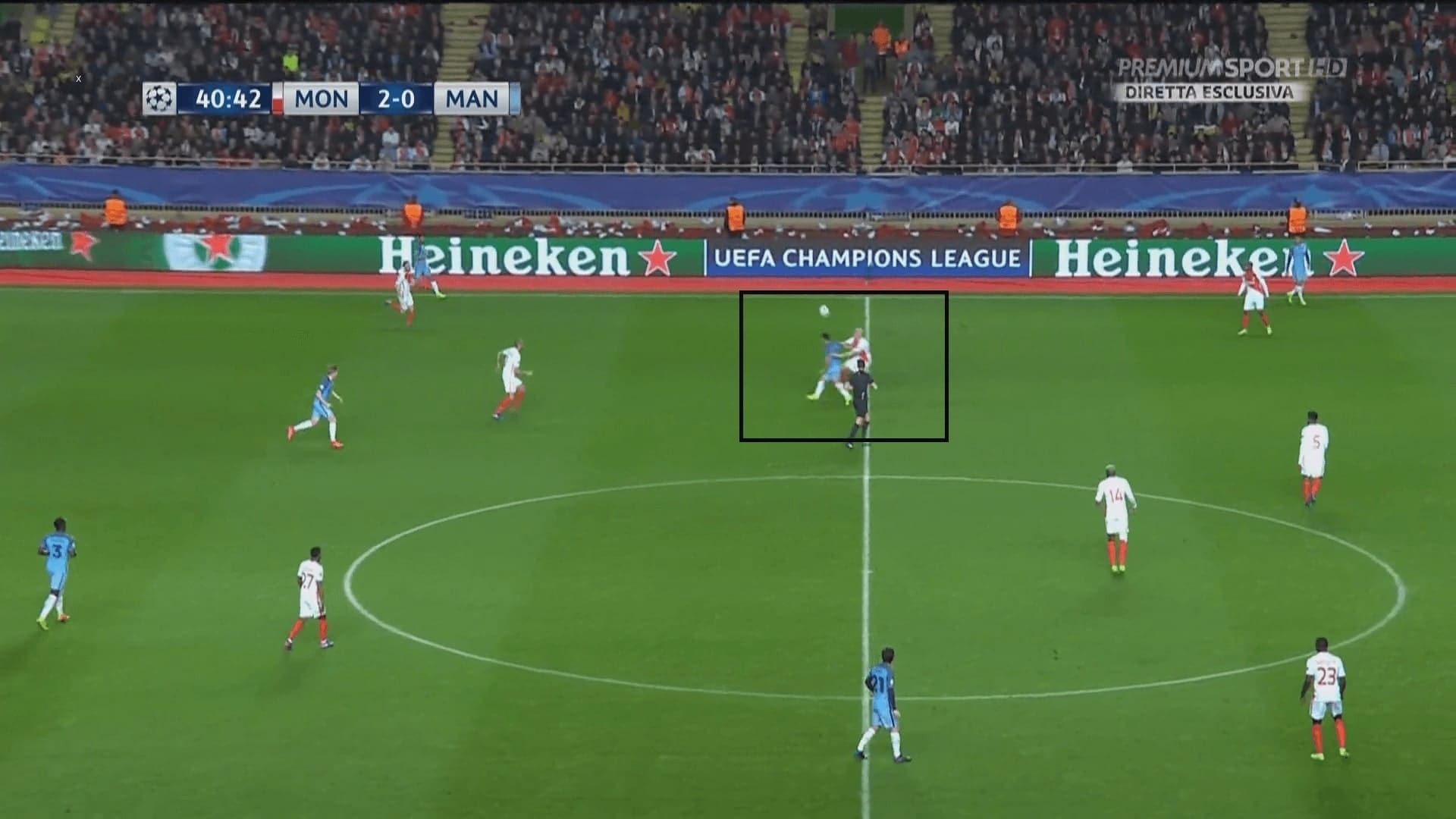
The stark contrasts
Despite the undesirable performance in the first half, City did manage to return to their normal standard after the break. They created a total of six shots with an xG of 1.11, as well as Sané’s goal. Some players were a lot better, and some of their roles changed a bit. Guardiola’s team adjusted the details of the attack, as they tried to solve the issues in the first half.
First, we want to show the differences in Sagna’s roles. In the first half, he could invert to the half-spaces, adding an extra number in the midfield. This strategy did not work too well as explained. Therefore, he was tasked to stay wider and attack the right side in the second half. The contrasts of his active zones were illustrated in the below graphs. The left graph was Sagna’s heat map in the first half, showing his actions at the half-spaces. The graph on the right showed the impact of Sagna in the opposition’s half.
Furthermore, Sagna had two crosses and two passes into the box in the last 45, which he recorded a zero on both categories in the first half.

So, who stayed deeper at the centre when Sagna left the midfield? The solution was De Bruyne. The presence of the Belgian made it an easier task for Fernandinho, as the vision and determination of De Bruyne helped City to produce the out-balls easier, even when they were under pressure. Not to mention, his passes were much better than the defenders.
For example, you could see in the below image, Fernandinho and De Bruyne were playing in the block of three to four Monaco players. The Belgian was absolutely fine to play in tight areas, he would not panic. Therefore, De Bruyne quickly passed the return ball to attack areas behind defenders.
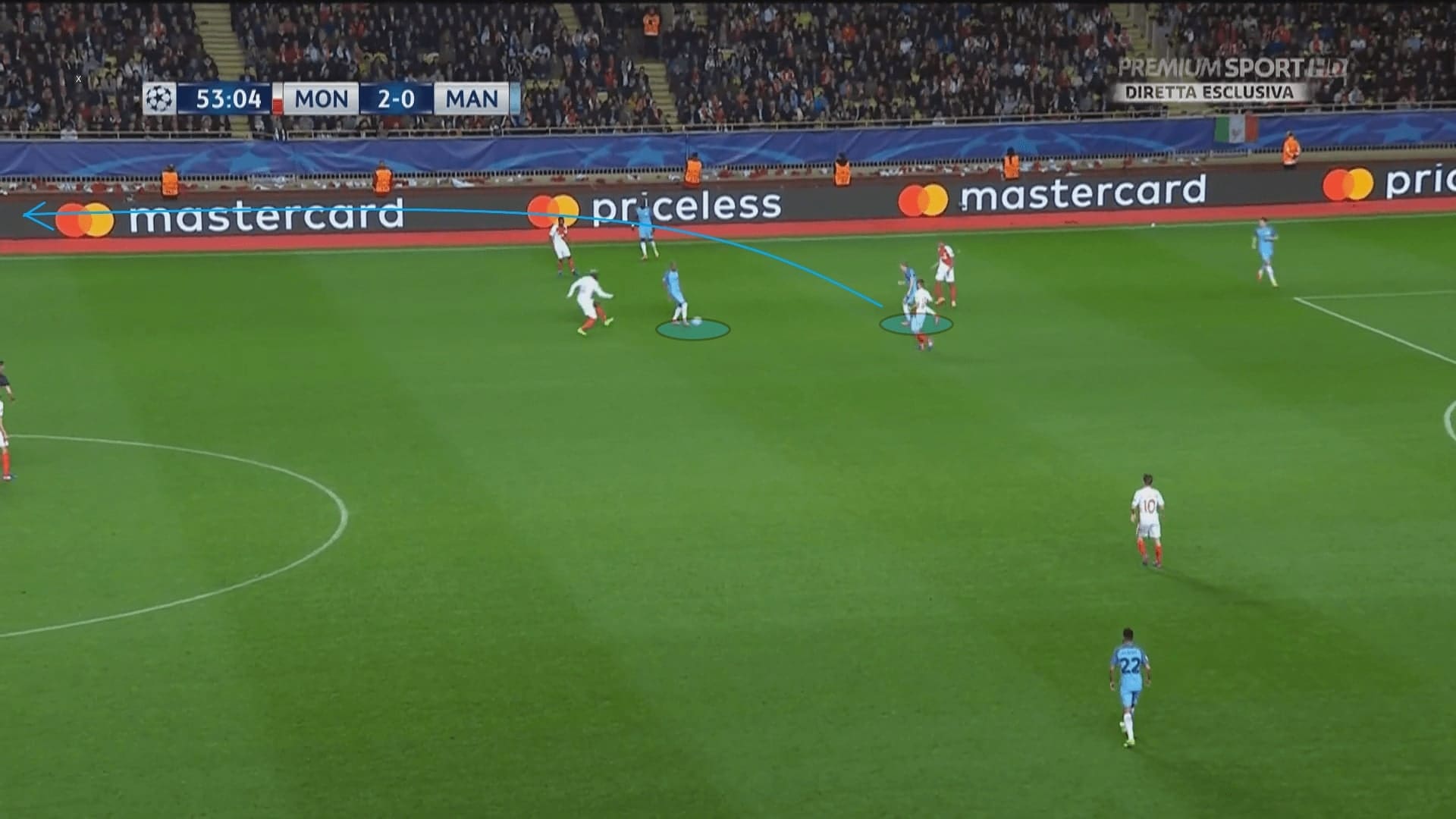
Playing De Bruyne at a deeper position also took him away from pressure. Therefore, the Belgian had more space and time to execute a pass, or even, penetrate the defence, as he did in this situation. Meanwhile, Sterling and Sané were tasked to run behind the defenders, increasing the depth of the attacks.
De Bruyne was free from pressure thanks to his deep positioning. It also meant he faced the opposition goal and had a wider angle to scan the pitch. This helped him discover the gap between defenders and the movement of his teammates easier. In this scenario, De Bruyne passed between Mendy and Jemerson to find Sterling, who ran behind the defenders.
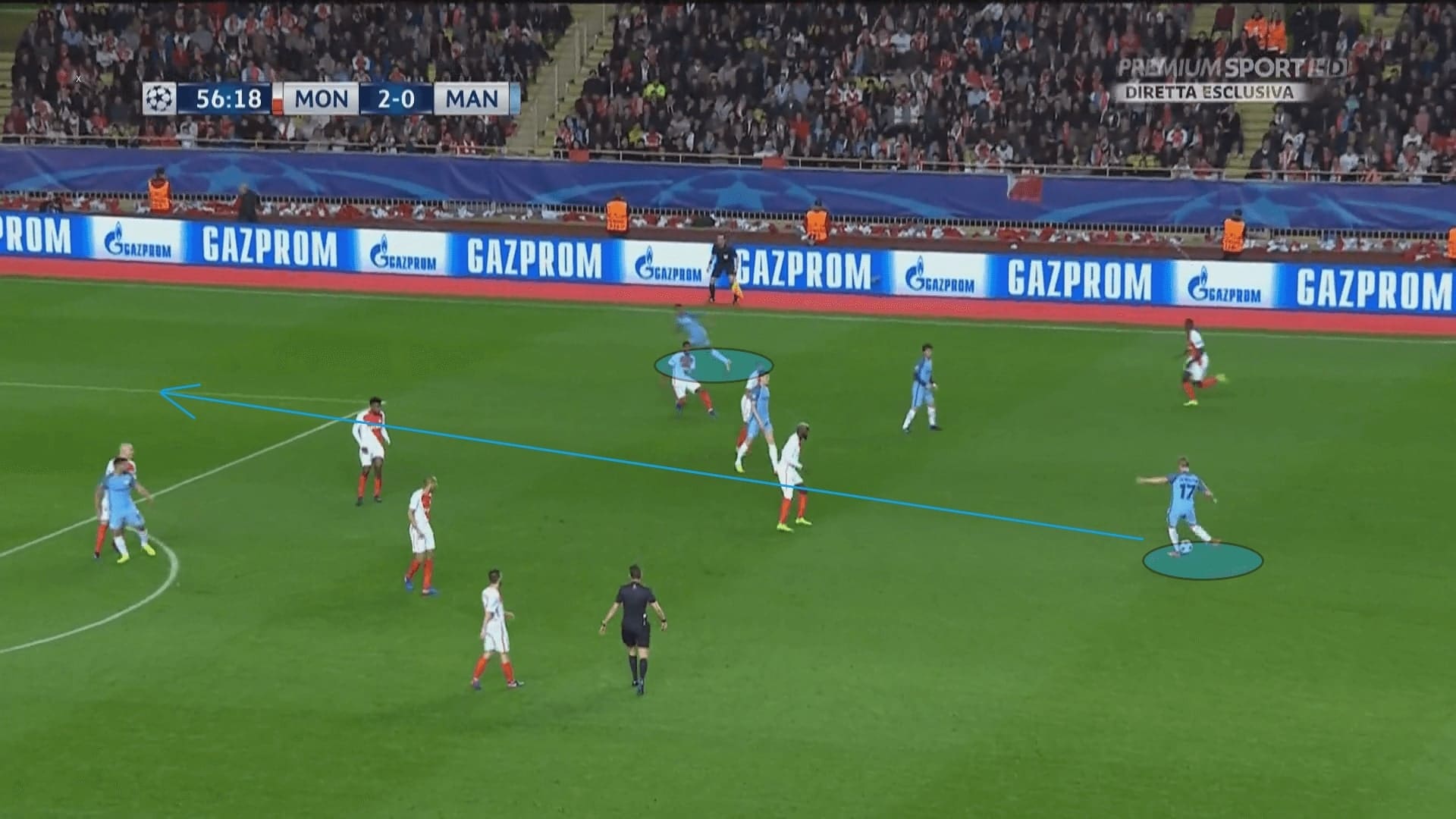
Apart from the change of De Bruyne’s role, City centre-backs were also given the freedom to carry the ball forward. The importance of such actions was to dribble past the defensive lines of Monaco and they absorbed pressure in the centre, leaving D. Silva more spaces to work in the opposition half.
In the below image, you could see Stones carried the ball and reached the central third. He left three Monaco players behind him in this process. Also, the English centre-back drew the attention of Fabinho and Bakayoko. With Stones’ presence, the central area was crowded, and at the same time, the wide channels were left open.
Therefore, D. Silva could appear and receive the ball away from the block, and Clichy as well. These two free players helped City to further progress the attack to the advanced area.
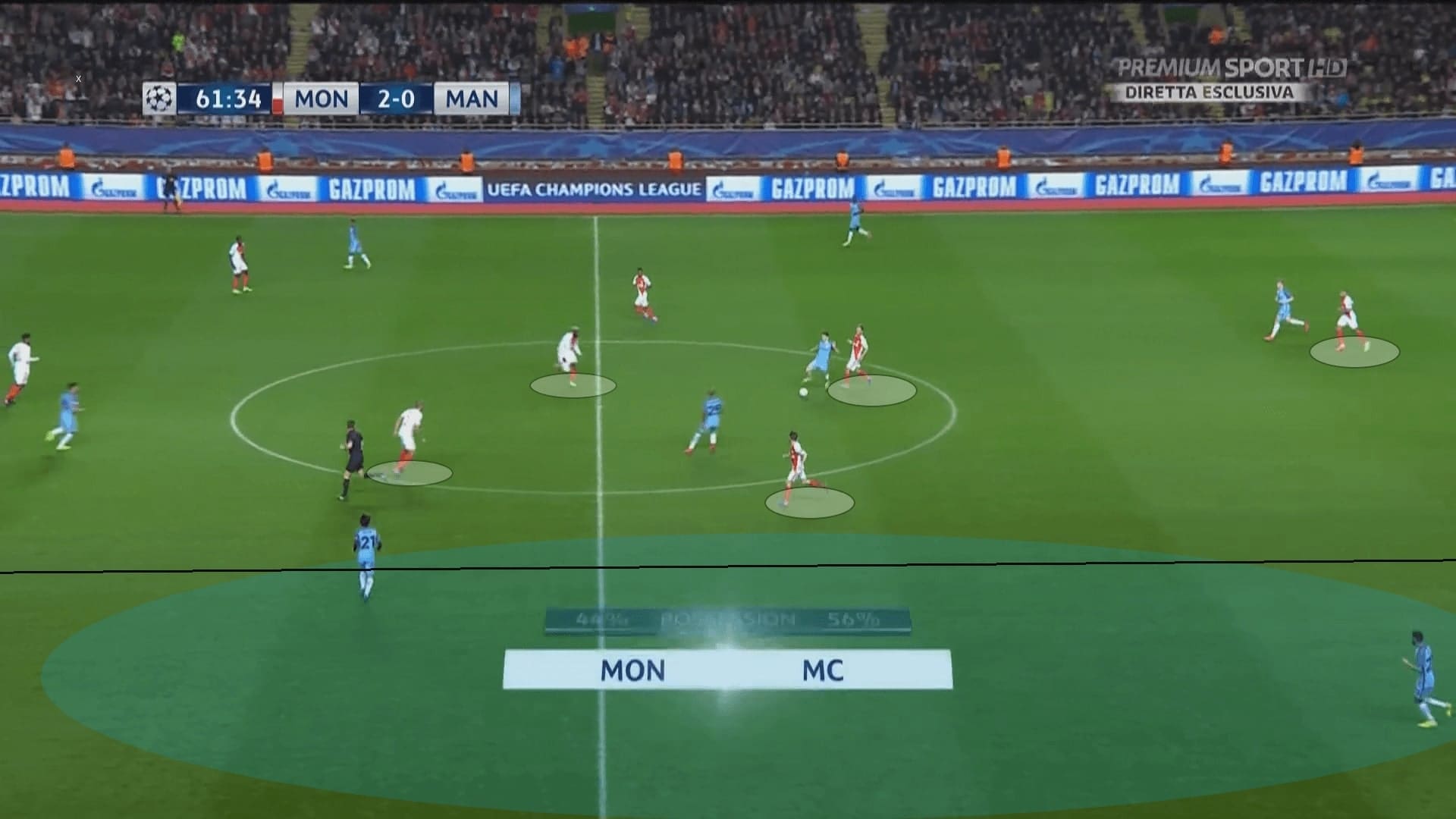
To further illustrate David Silva’s impact in the second half, we provide you with his heat maps before and after the break. The contrast is clear: in the first 45, D. Silva had to drop to his own half, exploiting spaces within the Monaco block. However, in the second half, he was active in Monaco’s half but seldom appeared at City’s half. More precisely, he was a threat at the half-spaces.
However, after Monaco scored their third, they placed more emphasis on D. Silva. The impact of the Spaniard diminished in the final stages of the game, mostly because of the introduction of Moutinho as explained.

There were certain events that happened around the Monaco backline, especially the half-spaces where City had many methods to exploit them. The first example we show was the wide positioning of the winger, Sané, whose outward movement took the right-back, Sidibé, with him. The distance between Sidibé and Raggi increased, allowing D. Silva to exploit with a forward, who then was released by Clichy.
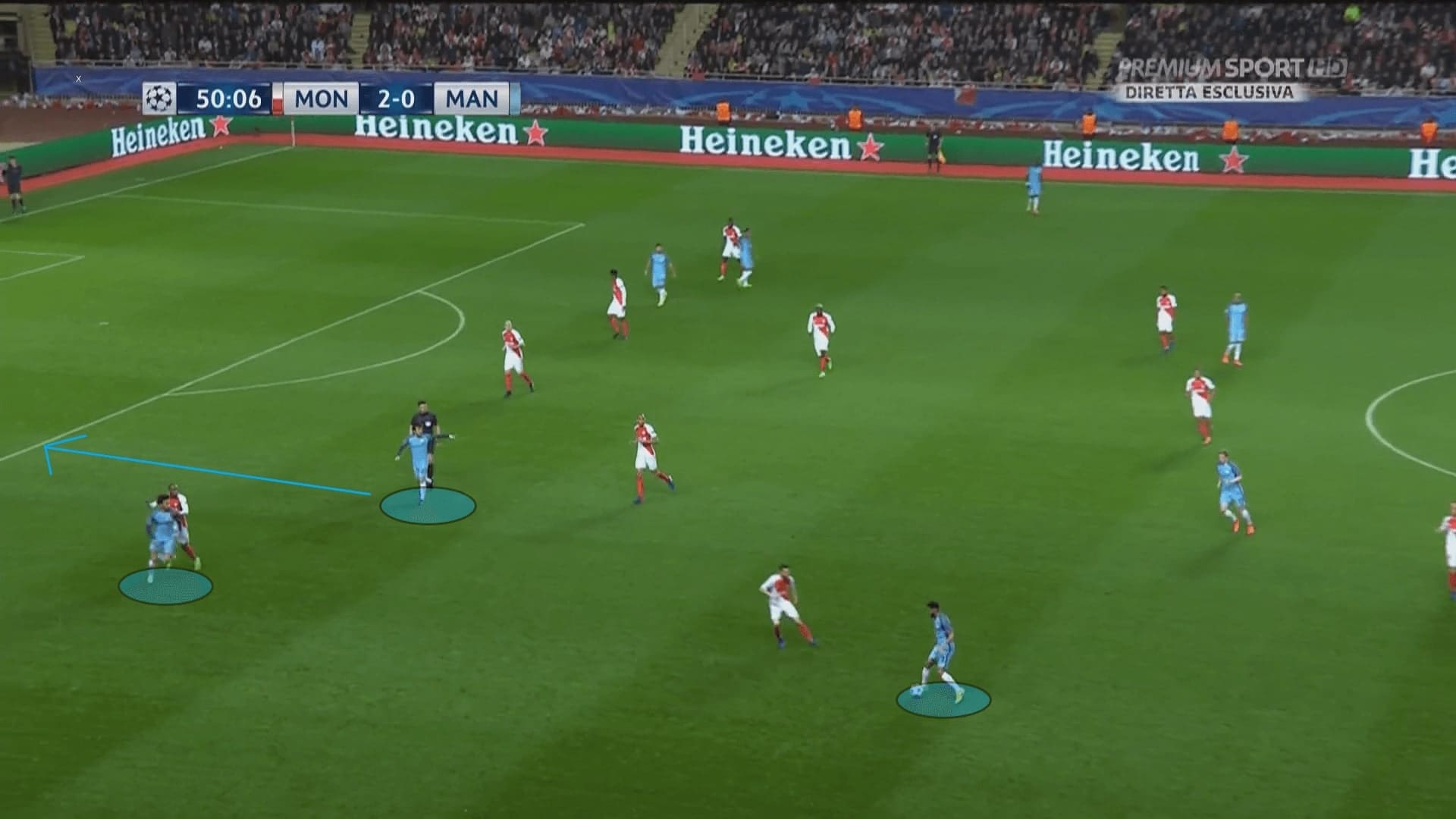
If D. Silva had the ball between the lines and at the half-spaces already, Sané or Sterling had the pace to run behind the defenders. The wide positioning allowed the wingers stayed on the full-backs’ blindsides, as Sidibé or Mendy were attracted by the ball and forced in suboptimal body orientations.
This was the situation of the below image, as Sidibé had to confront D. Silva at the half-spaces where the Spaniard cleverly passed through the gap of Raggi and Sidibé, releasing Sané to receive the ball in the box.
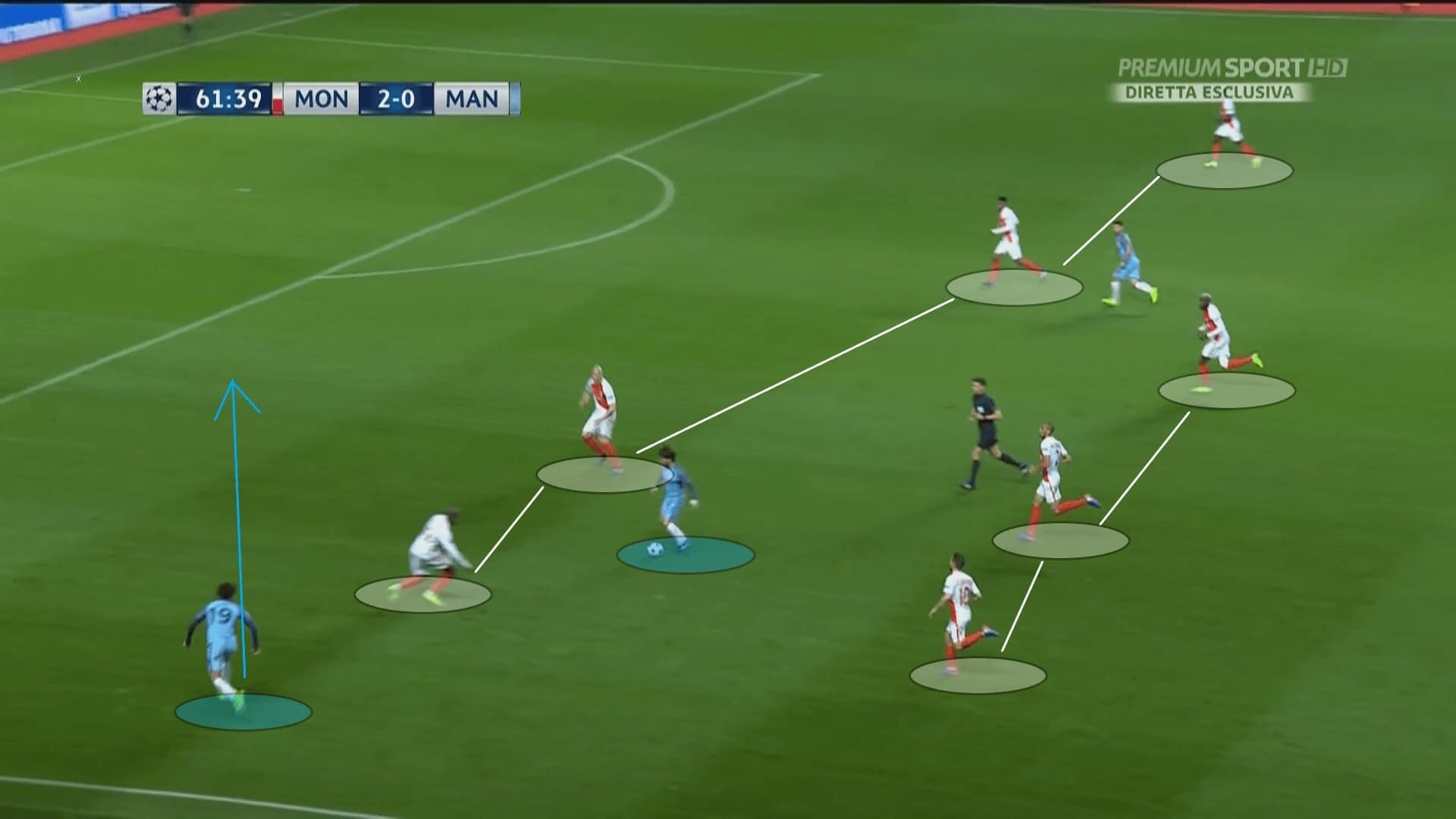
Apart from D. Silva, Agüero was another player improved his performance. He did better when countering the pressure at his back, holding the ball for seconds and then, the attack was progressed with a pass to the third man. Or, as in this scenario, he recognised spaces on City’s right flank and dribbled into it.
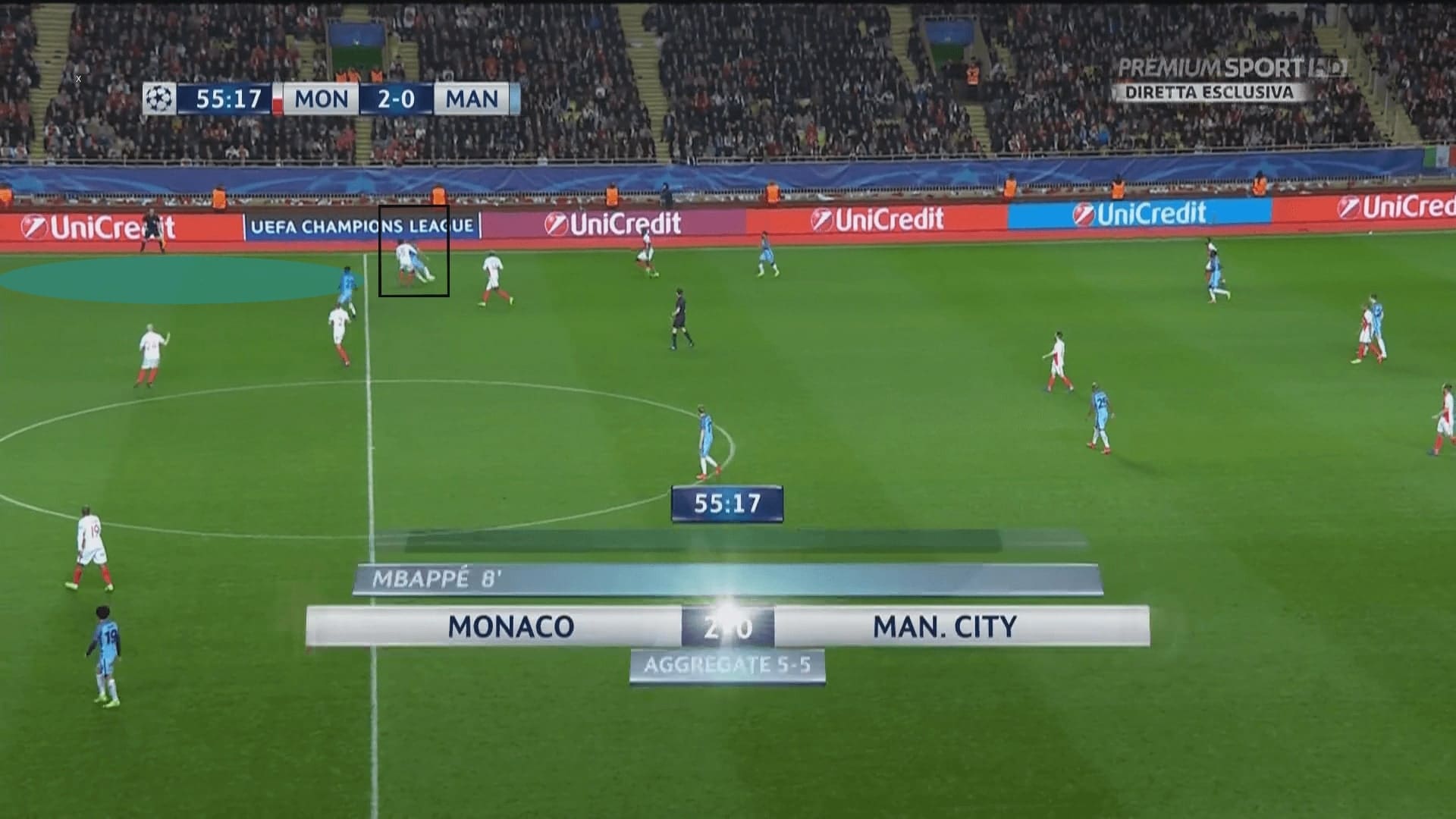
Conclusion
It must have been a disappointing game for City, as their efforts in the first leg were in vain. However, despite coming back from behind, Monaco did not really produce the performance to control the whole game. Jardim’s men were fragile when City gained control of the second balls.
In the first half, Monaco dominated the game with their intensive press. They also bagged some goals with the offensive full-backs. However, the performance did not carry on to the second half when City woke up and dominated the game as they did in all other games. Surprisingly, the finishing was less clinical than they did in the previous game, especially when Agüero missed a goal opportunity of 0.52.





Comments